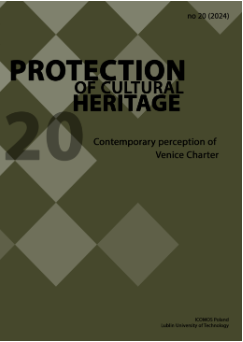Karta Wenecka – fundament ochrony dziedzictwa czy ciężar przeszłości? Odpowiedź na podstawie greckich doświadczeń
Dimitrios Zygomalas
jim_zs@yahoo.comMinisterstwo Kultury, Service of Modern Monuments and Technical Works of Central Macedonia (Grecja)
https://orcid.org/0000-0003-4156-7428
Abstrakt
W ciągu 60 lat od jej przyjęcia, Karta Wenecka stała się głównym punktem odniesienia w programie ochrony zabytków wielu krajów na całym świecie, zwłaszcza w Europie. Związek tego słynnego dokumentu z Grecją rozpoczął się już w momencie jego powstania; jeden ze współtwórców pochodził z Grecji, a mianowicie architekt Efstathios Stikas. Jednak pomimo tego wczesnego związku, wpływ Karty na greckie kwestie konserwatorskie był początkowo minimalny, a dopiero po 1974 roku stał się znaczący. W oparciu o badania bibliograficzne i archiwalne oraz osobiste doświadczenia, niniejszy artykuł ma na celu przegląd i ocenę rozwoju przydatności Karty w kontekście greckim, z naciskiem na jej wkład po 1974 r. w czterech głównych obszarach powiązanych działań: ustawodawstwo, sprawy sądowe, edukacja specjalistyczna oraz prace konserwatorskie i restauratorskie. Ocena ta stanowi podstawę do rozstrzygnięć na temat kulminacyjnej funkcji dokumentu, wraz z propozycjami optymalizacji jego przyszłego wkładu w program ochrony zabytków.
Słowa kluczowe:
Karta Wenecka, Grecja, edukacja, legislacja, ochrona, sprawy sądoweBibliografia
Bouras, Ch. (2010). I apokatastasi ton architektonikon mnimeion stin Ellada. Chroniko peninta eton, 1950-2000 (The restoration of architectural monuments in Greece. A chronicle of fifty years, 1950-2000). In Ch. Bouras & P. Tournikiotis (Eds.), Syntirisi, anastilosi kai apokatastasi mnimeion stin Ellada, 1950-2000 (Conservation, anastylosis and restoration of monuments in Greece, 1950-2000). (pp. 29-72, especially pp. 30-69). Piraeus Bank Group Cultural Foundation.
Google Scholar
Lebidaki, E. (Ed.). (2011). The restoration of the monuments of the Athenian Acropolis. Acropolis Restoration Service.
Google Scholar
Lebidaki, E. (Ed.). (2018). O Charalampos Bouras kai i anastilosi ton mnimeion tis Akropolis (Charalampos Bouras and the anastylosis of the Acropolis monuments). Acropolis Restoration Service.
Google Scholar
Mallouchou-Tufano, F. (2010). Nees epistimonikes apaitiseis versus kathieromenes praktikes. Oi periptoseis tis anastilosis tou Ierou tis Samothrakis kai tou Odeiou tou Irodou tou Attikou (New scientific requirements versus established practices. The cases of the anastylosis of the Sanctuary of Samothrace and the Odeon of Herodes Atticus). In Ch. Bouras & P. Tournikiotis (Eds.), Syntirisi, anastilosi kai apokatastasi mnimeion stin Ellada, 1950-2000 (Conservation, anastylosis and restoration of monuments in Greece, 1950-2000). (pp. 131-156, especially pp. 131, 144, 148). Piraeus Bank Group Cultural Foundation.
Google Scholar
Pavlidis, G., Sarvani, P., & Massen, V. (2020). Megaro Longou, Apokatastasi kai epanachrisi diatiriteou mnimeiou sti Thessaloniki (Loggos Mansion, Restoration and reuse of listed monument in Thessaloniki). Ktirio, 3, 32-43.
Google Scholar
Trakosopoulou-Tzimou, K. (2001). Apokatastasi tis epavlis A. Kapantzi stin Thessaloniki kai epanachrisi tis os edra tou Organismou gia tin Politistiki Protevousa tis Evropis ΄97 (Restoration of the mansion of A. Kapantzi in Thessaloniki and reuse as headquarters of the Organization for the Cultural Capital of Europe ‘97). In M. Nomikos (Ed.), Apokatastasi - Epanachrisi Mnimeion kai Istorikon ktirion sti Voreia Ellada (Restoration - Reuse of Monuments and Historic buildings in northern Greece). (Vol. II, pp. 118-139). Ergon IV.
Google Scholar
Zygomalas, D. (2004). Anakataskefes se archaia mnimeia tou elladikou chorou: I empeiria tis armonika entassomenis kai diakritis prosthikis (Reconstructions in ancient monuments of Greece: The experience of the harmonically integrated and distinguishable addition). In K. Trakossopoulou, M. Doussi, & N. K. Hatzitrifon (Eds.), Proceedings of the 2nd National Conference “Appropriate interventions for the protection of historic structures” (Vol. 1, pp. 81-91). Hellenic Ministry of Culture - Technical Chamber of Greece.
Google Scholar
Zygomalas, D. (2005). On top of the monument: A review of post-war extensions over the historic buildings of Thessaloniki, Greece. Poster in the digital proceedings of the XXII World Congress of Architecture “UIA2005istanbul, Cities: Grand Bazaar of ArchitectureS”. UIA.
Google Scholar
Zygomalas, D. (2006). Educating on conservation: The Greek experience in preparing specialists in built heritage preservation and enhancement. In S. Andolsun, A. Temizsoy, & M. Uçar (Eds.), Built Environment & Information Technologies, Proceedings of 1st International CIB endorsed METU postgraduate conference (pp. 85-98, especially pp. 86-91). Middle East Technical University, Faculty of Architecture.
Google Scholar
(1975). Constitution of Greece (Government Gazette 111/v. A/09-06-1975, art. 24).
Google Scholar
(1977). Presidential Decree 941/15-10-1977. “Peri Organismou tou Ypourgeiou Politismou kai Epistimon” (Regarding the Structure of the Ministry of Culture and Sciences). (Government Gazette 320/v. A/17-10-1977).
Google Scholar
(1985). Law 1577. “Genikos Oikodomikos Kanonismos” (General Building Regulation). (Government Gazette 210/v. A/18-12-1985, art. 4).
Google Scholar
(1992). Law 2039. “Kyrosi tis Symvasis gia tin prostasia tis architektonikis klironomias tis Evropis” (Ratification of the Convention for the protection of the architectural heritage of Europe). (Government Gazette 61/v. A/13-04-1992).
Google Scholar
(2000). Law 2831. “Tropopoiisi ton diataxeon tou nomou 1577/1985” (Modification of the clauses of Law 1577/1985). (Government Gazette 140/v. A/13-06-2000, art. 3).
Google Scholar
(2002). Law 3028. “Gia tin prostasia ton Archaiotiton kai en genei tis Politistikis Klironomias” (For the protection of the Antiquities and Cultural Heritage on the whole). (Government Gazette 153/v. A/28-06-2002).
Google Scholar
(2005). Law 3378. “Kyrosi tis Evropaikis Symvasis gia tin prostasia tis archaiologikis klironomias, anatheorimeni” (Ratification of the European Convention on the protection of the archaeological heritage, revised). (Government Gazette 203/v. A/19-08-2005).
Google Scholar
(2012). Law 4067. “Neos Oikodomikos Kanonismos” (New Building Regulation). (Government Gazette 79/v. A/09-04-2012, art. 6).
Google Scholar
(2019). Ministerial Decision 356112/929/02-07-2019. “Kanonistiko plaisio gia tin ekponisi meleton kai tin ektelesi ergasion se akinita mnimeia” (Regulatory framework for the preparation of projects and the conduct of works on immovable monuments). (Government Gazette 2837/v. B/05-07-2019).
Google Scholar
(2021). Law 4858. “Kyrosi Kodika nomothesias gia tin prostasia ton Archaiotiton kai en genei tis Politistikis Klironomias” (Ratification of Codex for the protection of the Antiquities and Cultural Heritage on the whole). (Government Gazette 220/v. A/19-11-2021).
Google Scholar
Autorzy
Dimitrios Zygomalasjim_zs@yahoo.com
Ministerstwo Kultury, Service of Modern Monuments and Technical Works of Central Macedonia Grecja
https://orcid.org/0000-0003-4156-7428
Statystyki
Abstract views: 48PDF downloads: 24









